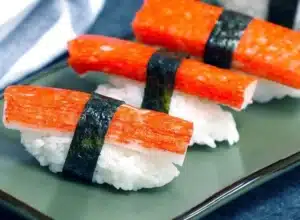Kanikama
What is Kanikama (or Surimi)
 Kanikama (sometimes abbreviated as kani), or imitation crab meat, is the sticks of fake crab meat (some companies also make a lobster flavor) which is the “crab” used to make the popular California roll among other sushi items. Kanikama is processed from surimi, which is a paste created by grinding and combining different species of fish in order to mimic crab leg meat (for California rolls for example) or other shellfish.
Kanikama (sometimes abbreviated as kani), or imitation crab meat, is the sticks of fake crab meat (some companies also make a lobster flavor) which is the “crab” used to make the popular California roll among other sushi items. Kanikama is processed from surimi, which is a paste created by grinding and combining different species of fish in order to mimic crab leg meat (for California rolls for example) or other shellfish.
Non-Japanese people sometimes confuse the two words, but surimi is the basis from which many food items are made, among them is kanikama (AKA “kani” as abbreviations, as abbreviations, contractions, and other ways to shorten words and phrases is common and valued in Japanese culture). A product similar to kanikama, called kamaboko is also made from surimi, and is typically shaped into tubed or a shape like a loaf of bread and sliced, with the exterior often dyed pink instead of red, pink and white and is associated with good luck in Japan.
The meaning of “surimi in Japanese is literally “ground meat” which makes sense, though it is only used in the context of a fish paste, not other meats (other than jokingly or idiomatically).
How Kanikama Is Made – The Story of Surimi
The surimi used to create kanikama is composed mainly of Alaskan pollock, sourced from the north Pacific ocean. It includes smaller quantities of other white fish, as well as binding ingredients such as egg white and corn starch. Because it is composed of mainly white fish, the outer layer has a of kanikama is colored with red food coloring to enhance its appearance, making it look more like a crab leg when cooked. Kanikama is typically flavored with a crab flavoring, which is either artificial or derived from real crab, which allows it to mimic the taste of the more expensive ingredient, however numerous other flavors are available..
The coloring used to brighten kanikama is one of the indicators to tell if you are consuming real crab or imitation. Imitation crab will often have a bright red strip, whereas real crab has a light, pink tone on top. Another way to discern the two products is to look for muscle striation, or ridges or furrows in the meat. As imitation crab is made of ground fish, it will not have these irregularities.
But How Does Kani Taste?
The flavor of kanikama is quite similar to that of real crab. It is mild and slightly sweet, and often lower in cholesterol than the real deal. Kanikama is low in fat as well. If you are newer to sushi, it is likely that you will be hard pressed to discern the difference in tastes and textures of kanikama and more expensive real crab. This has led to the dramatic increase in use of imitation crab meat in sushi rolls.
While kanikama is cheaper and very similar in taste to crab, one problem with it is that it’s hard to know exactly which chemicals and binding ingredients were used to create of the product. One of the charms of sushi is knowing exactly what you are eating in its pure and simple form, and while kanikama is widely used in restaurants throughout the world, it does not have quite the same complex, nuanced, and subtle flavor as real crab meat.
I have always been fascinated by the creation and culture of different foods, particularly sushi and sashimi in the modern era of Japanese cuisine. I am a classically trained chef and sushi connoisseur, also having operated a food service company and enjoy investigating and experimenting with food around the world.